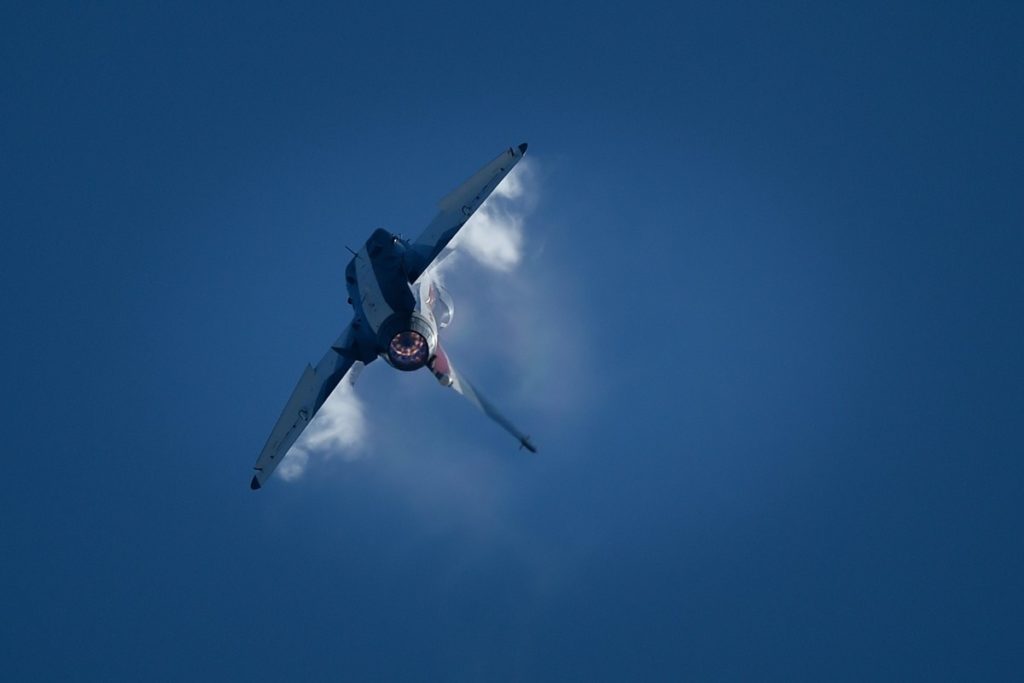Support SouthFront

A J-10 fighter jet of the Bayi Aerobatic Team of the Peoples Liberation Army Air Force performs at the Zhuhai air show in south China’s Guangdong province on Nov. 6, 2018. IMAGE: Wang Zhao/AFP
Defense News reports (source):
China is continuing to show signs of technological advancement in its fighter jets that could lead to further improvements in its own next-generation stealth fighter, according to an air power expert.
These improvements are on display at the ongoing Zhuhai air show in China, where both the Chengdu J-10 fighter and J-20 stealth fighter are taking part in flight demonstrations.
This includes a J-10B test bed fitted with a domestically developed WS-10B3 turbofan engine that incorporates a thrust vectoring exhaust nozzle, with its demo showcasing improved maneuverability and slow-speed handling. The J-10B with the WS-10B3 is making its first appearance in Zhuhai, having only been seen for the first time earlier this year at the headquarters of manufacturer Chengdu Aircraft Company in its namesake city in Sichuan province.
Justin Bronk, a research fellow specializing in combat air power and technology in the Military Sciences team at the British think tank Royal United Services Institute, told Defense News that the thrust vectoring nozzle “clearly has enhanced the controllability of the J-10B in terms of allowing it to perform controlled manoeuvers outside of aerodynamic flight conditions.”
However, Bronk added, most Western air forces have concluded that the usage of thrust vectoring for an edge in a dogfight is generally not worth the extra cost, weight and complexity, given “most modern dogfighting missiles have lock-on-after-launch capabilities, 50 G turn rates and relatively large no-escape zones.”
Nevertheless, there is potential use for thrust vectoring on the J-20, as it can help reduce the need for canard deflections when performing slight directional adjustments, and it will improve the J-20’s stealth characteristics, given its large, forward-mounted canards are detrimental to its forward aspect stealth.

A Chinese J-20 stealth fighter performs at the Zhuhai air show in southern China’s Guangdong province on Nov. 6, 2018. IMAGE: Wang Zhao/AFP
This is an important consideration for stealthy, low-observable designs in combat situations, as they seek to reduce their probability of detection when approaching an adversary. Bronk said the thrust vectoring nozzle on the J-10B test bed “appears shaped to better minimize radar cross-section than the current (Russian) AL-31 engines on the J-20.”
Indeed, at the air show, Yang Wei, the chief engineer of the J-20 program, cryptically responded with a cheeky “how do you know we haven’t already done so?” when asked by a local reporter if the J-20 will be similarly fitted with WS-10 engines incorporating thrust vectoring control.
J-20 prototype aircraft assigned to the Chengdu Aircraft Company have already flown with WS-10 engines, and it’s rumored the J-20 has flown while fitted with thrust-vectoring variants of the WS-10.
Meanwhile, high-resolution photos taken at Zhuhai reveal the low-rate initial production models of the J-20 operated by China’s air force are showing signs of what Bronk calls “rapid quality improvement.” He noted that these aircraft exhibit improvement “on surface quality and mold-line consistency compared to previous prototypes, showing China continues to make progress in closing the gap with U.S. low-observable designs.”
Nonetheless, he told Defense News, China still has a fair way to go before it can approach the levels of signature reduction seen in fifth-generation fighters such as the F-22 and F-35. He contributed this to the continued presence of external attachments and the less-than-ideal way the electro-optical targeting system of the J-20 and its engine nozzles are mounted.
The J-20 is not on static display at this year’s Zhuhai air show, but up to four aircraft are supporting the show, operating from a nearby airbase and flying during daily demonstrations.
Support SouthFront








I hope the Chinese aircraft User Manuals are clearer than the the manual for Chinese security camera I bought.
If not the pilots are really in deep shit :)
Lol
I once saw the English text on some Chinese made medical utilities in an Iranian store, it was pure randomly created gibberish. It literally meant nothing.
It amazes me that the producers of the translations do not employ literate proof readers who were born and live in in the countries they wish to export goods to and also get them to use the manuals to ascertain if the instructions are workmanlike.
I always thought so too. Then again its not just the Chinese. I remember building Japanese model kits in the 90’s, and their English texts then were equally a crime against the English language. Excellent quality kits though.